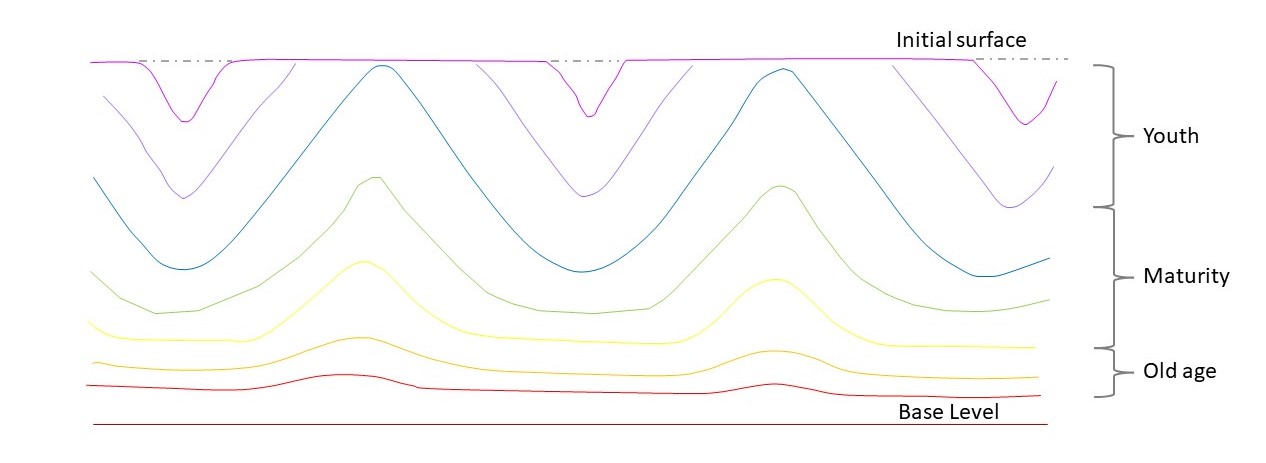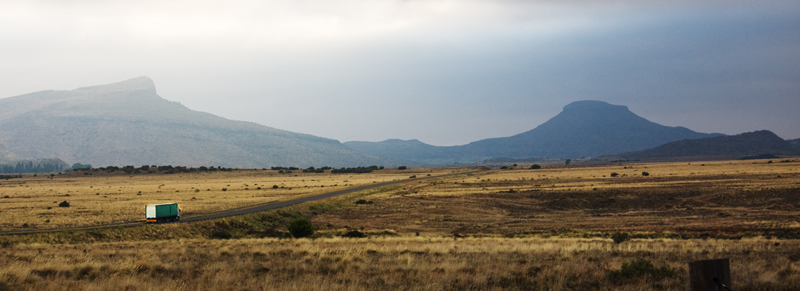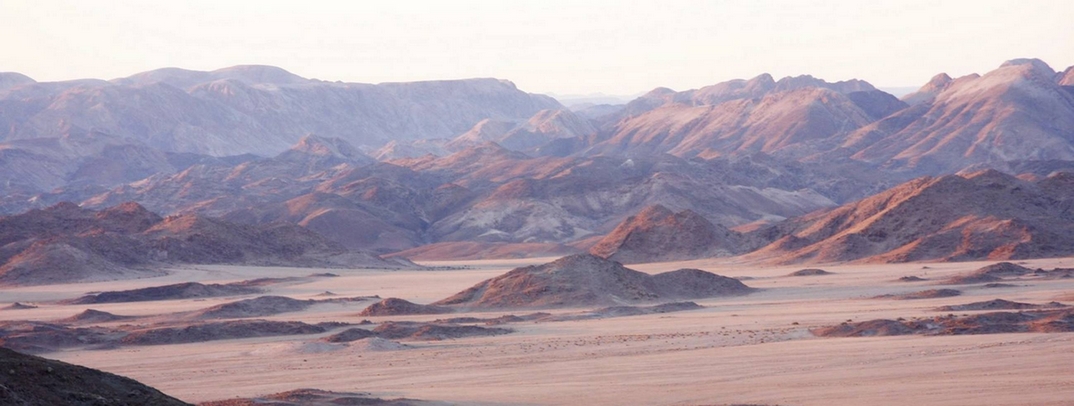William Morris Davis towered above the geomorphological landscape a 100 years ago. He is remembered chiefly for his theory on the evolution of landscapes which was immensely influential at the time, and although his theory has shown to be flawed in some respects, he at least stimulated the discussion around the topic, and his theory still holds water to some degree, with caveats of course. It still remains a pervasive idea in geomorphology.

Let us look a little more closely at W.M. Davis’ theory, which he called the Geographical Cycle. Just to clarify, a cycle starts at some initial state, followed by a sequence of events which eventually arrives at some ultimate state, which resembles the original form. The term ‘cycle’ implies this – a journey around the sun is a cycle, which we call a year. Spinning a bicycle wheel back to its original position is a cycle, and so forth. Returning to things geomorphological, a new cycle begins when the base level changes, either due to uplift or a fall in sea level. Both of these events inject energy into the system.

The Davisian Cycle - starting at an initial surface, erosion reduces the landscape down to a flat base level over time.
The thinking goes like this: Imagine rapid uplift of a block of land – ideally flat. With time the streams cut steep sided, V-shaped valleys into the initial landmass, which of course increases the relief. As the process progresses, the landscape becomes dominated by valley slopes. Maturity arrives when the valley sides intersect with each other at the interfluves. At this stage the last remnant of the initial landscape disappears. The rivers begin to form flood plains and the erosive power and downcutting of the valley floors falls off. Through maturity, the relief of the region decreases steadily and the slope angles decrease. Old age arrives when the landscape is reduced to a low, undulating surface dominated by shallow gradients and extensive flood plains. Davis coined the term “peneplain” for this surface. Interruptions in the cycle could occur due to climate change or base level change, leading to rejuvenation.
Davis claimed that there are 3 controls of landscape development
Davis put forward his theory in 1899, which he called the ‘Geographical Cycle’ as we have already seen. He pointed out that there were 3 main controls on landscape development, namely structure, which in this case means the underlying geology; process, the mechanisms of landscape change, and stage, the length of time the processes have been operating. Davis focussed most of his attention on the last factor, and divided the cycle into 3 stages – youth, maturity and old age.
This is all very elegant on the face of it

This is all very elegant on the face of it. From a geologist’s point of view, it is a worry that he neglects the structure and the process controls. We shall take a closer look at how geological structures affect the landscape in another post.
Davis thought that his cycle should be the normal one for all landscapes but later modified his views when confronted with evidence from glacial and desert landscapes – believing that these environments deserved their own separate cycles.
Walther Penck and then Lester King came up with an alternative theory – that of pediplanation – which also adhered to the notion of a cyclical process. He proposed that parallel retreat of slopes, leading to the formation of a nearly horizontal pediplain, was the normal cycle for the world, rather than that of peneplanation. King claimed to be the world’s greatest geomorphologist, and plied his trade out of what was the University of Natal in South Africa. More on King’s theory can be found here.
And if you really want comprehensive insights into landscape formation why not take our Rock and Weathering Course? Find out more by clicking on the link below.
Evolution of Landscapes
We take an in depth and integrated look at how our Earth formed, the development of plate tectonics, how this operating system drives the rock cycle to form the rock trinity of igneous, metamorphic and sedimentary rocks. We also dive into the formation of fold mountains, folding, faulting and igneous intrusions. And armed with this knowledge we then venture out onto the peneplains and pediplains to do battle with scarp retreat and the evolution of landscapes.
King insisted that … "polycyclic landscapes are incompatible with peneplanation, but are a natural consequence of scarp retreat." Anyone who has driven across the vast hinterland of southern Africa can attest to why King arrived at this conclusion – the landscape is dominated by mesas and buttes, which are locally known as koppies or kopjes. It was Arthur Holmes in his seminal work Principles of Physical Geology who wrote: “By far the most spectacular examples of the co-existence of landscapes of successive cycles of erosion are to be seen in Africa.”

Southern Africa's hinterland is dominated by vast landscapes, mesas and buttes, locally known as koppies.
As an aside, one of the stands at the Anfield football stadium is called The Kop, which is the shortened version of Spionkop where British soldiers from Liverpool died fighting back in 1900 during the Anglo Boer War. The word is an Afrikaans one, which literally means ‘head’.
There has been a great deal of condemnation of erosion cycles, ranging from detailed criticism of the mode of operation of the Davisian cycle, to the utter rejection thereof. The first criticism is that much of cyclical thinking is based on untested assumptions. The second is that the acceptance of these ideas has led researchers to seek out historical evidence to reconstruct the stages of the evolution of the landscape, to the exclusion of all else.

Most geomorphologists now regard the Davisian cycle as inaccurate at best and misleading at worst. There is little evidence to support the idea that landforms evolve to an inevitable end result – the peneplain. Nor is there much evidence to support the notion that steep slopes are ‘young’, and that gentle slopes are ‘old’. In sort, there is a fundamental objection to the Davisian cycle idea that the angle of the slope or the channel pattern of a river provides us with information on their age.
In addition, this raises the question of whether flat erosion surfaces can ever be created totally by slope decline, as the energy required to erode way the remnant slopes is too low to do the necessary work. Finally, the time required to complete a Davisian cycle may be many millions of years, and judging by the Cainozoic era base-level changes that have taken place with great rapidity, one would assume that similar changes have taken place in the greater geological past, which would deny a landscape sufficient time to complete a full Davisian cycle.
Looking forward to your comments and feedback in the comments box below. And don't miss out on the Rock and Sky courses - they will change your life.
Evolution of Landscapes
We take an in depth and integrated look at how our Earth formed, the development of plate tectonics, how this operating system drives the rock cycle to form the rock trinity of igneous, metamorphic and sedimentary rocks. We also dive into the formation of fold mountains, folding, faulting and igneous intrusions. And armed with this knowledge we then venture out onto the peneplains and pediplains to do battle with scarp retreat and the evolution of landscapes.

